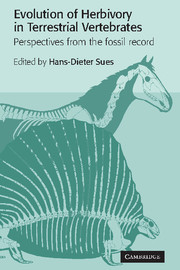Book contents
- Frontmatter
- Contents
- List of contributors
- Preface
- 1 Herbivory in terrestrial vertebrates: an introduction
- 2 Herbivory in late Paleozoic and Triassic terrestrial vertebrates
- 3 Prosauropod dinosaurs and iguanas: speculations on the diets of extinct reptiles
- 4 The evolution of sauropod feeding mechanisms
- 5 Plant-eaters and ghost lineages: dinosaurian herbivory revisited
- 6 Dental constraints in the early evolution of mammalian herbivory
- 7 Patterns in the evolution of herbivory in large terrestrial mammals: the Paleogene of North America
- 8 Origin and evolution of the grazing guild in Cenozoic New World terrestrial mammals
- Taxonomic index
- Subject index
6 - Dental constraints in the early evolution of mammalian herbivory
Published online by Cambridge University Press: 22 October 2009
- Frontmatter
- Contents
- List of contributors
- Preface
- 1 Herbivory in terrestrial vertebrates: an introduction
- 2 Herbivory in late Paleozoic and Triassic terrestrial vertebrates
- 3 Prosauropod dinosaurs and iguanas: speculations on the diets of extinct reptiles
- 4 The evolution of sauropod feeding mechanisms
- 5 Plant-eaters and ghost lineages: dinosaurian herbivory revisited
- 6 Dental constraints in the early evolution of mammalian herbivory
- 7 Patterns in the evolution of herbivory in large terrestrial mammals: the Paleogene of North America
- 8 Origin and evolution of the grazing guild in Cenozoic New World terrestrial mammals
- Taxonomic index
- Subject index
Summary
Introduction
The processing of plant food in mammals requires specialized mechanisms in order to sustain high rates of nutrient assimilation, and the evolution of herbivory in mammals can potentially be traced by examining changes in these structures. Conditions suitable for the preservation of soft tissues are exceedingly rare (Schaal and Ziegler 1993), and thus we cannot hope to trace the evolution of herbivory using structures of the stomach and intestinal tract. However, oral comminution of plant material is a nearly universal behavior among mammalian herbivores, owing to the problem of breaking down the plant cell walls composed of cellulose (Janis and Fortelius 1988). Fortunately, dental structures specialized for this purpose are well represented in the fossil record. One major group of Mesozoic mammals, the multituberculates, had already acquired masticatory mechanisms allowing herbivory (Hahn 1971; Krause 1982). However, the main mammalian radiation that led to modern herbivores probably occurred immediately following the extinction of the non-avian dinosaurs at the end of the Cretaceous. That event must have opened many niches that previously had been inaccessible to mammals, judging from the high taxonomic and morphological rates of evolution across the Cretaceous–Paleocene boundary (Sloan 1987).
This chapter examines the functional changes in the shapes of teeth in the two dominant groups of early Paleocene ungulates in North America, compares these with common Eocene ungulates, and considers the influence that tissue strength had on the directions of these changes. The results indicate that the changes were non-linear, apparently because of mechanical constraints that had to be overcome before the more efficient mastication characteristic of modern ungulates emerged.
- Type
- Chapter
- Information
- Evolution of Herbivory in Terrestrial VertebratesPerspectives from the Fossil Record, pp. 144 - 167Publisher: Cambridge University PressPrint publication year: 2000
- 4
- Cited by



